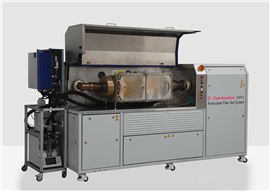Cambustion launches particulate filter test for heavy-duty engines
25 September 2024
 Cambustion particle filter test solution for the industrial engine market (Photo: Cambustion)
Cambustion particle filter test solution for the industrial engine market (Photo: Cambustion)
UK-based Cambustion has released a new version of its particle filter test system which has been designed for the industrial engine market.
The filter test solution is intended to improve development and performance analysis of exhaust equipment used in the heavy-duty industrial sector.
The latest version a ‘condensed’ version of the original Cambustion DPG particle filter test system, widely used as an end-of-line quality test for diesel particulate filters and gasoline particulate filters used in the automotive sector.
While retaining the core features of this tech, the new version is described as a lower-cost adaptation designed to support industrial engine OEMs and engine aftertreatment companies as they work to meet stringent global particle standards for vehicles used in construction, agriculture and mining industries.
The new model is also suitable for use with engines used on ships, trains and aircraft.
Speaking about the new particulate filter, Ryan Mulholland, senior DPG and Applications engineer at Cambustion, said that the new tech builds on the proven track record of the original, launched almost 20 years ago.
“We’ve now streamlined the technology to reduce costs without compromising on essential capability,” said Mulholland. “In this way, we’ve made the solution accessible to manufacturers and aftertreatment companies in the heavy-duty industrial markets as they address the challenge of measuring and improving the performance of particle filter technologies.”
The equipment is designed to test the particle filter to its limits, while simultaneously measuring and recording performance data. This data can be used to support aftertreatment system development, while testing overall durability and performance.
Mulholland added: “Our DPG system is the only equipment that can confirm filtration efficiency at the full operating flow and temperature of the filter. It does this by controllably loading the filter with soot and ash and measuring how this affects the backpressure and filtration efficiency.
“The system can simulate soot regenerations and full lifecycles to measure the robustness of the filter dramatically faster and more economically than with engine testing.”
CONECTAR-SE COM A EQUIPE





